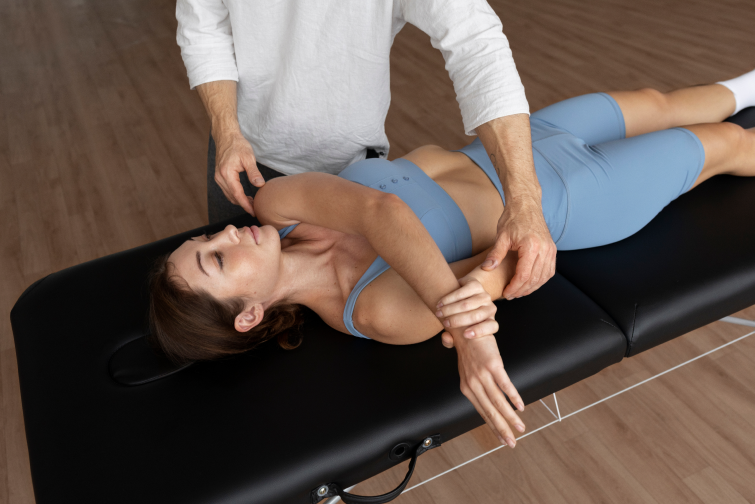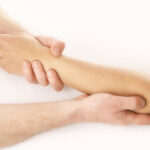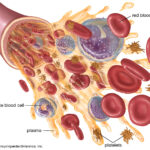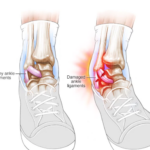Shoulder Anatomy
The shoulder complex is made up of 3 joints: the Glenohumeral joint, the Acromioclavicular joint, and the Sternoclavicular joint. The most commonly affected during a dislocation is the Glenohumeral joint. This joint is a ball and socket joint, which is one of the most mobile types of joints in the body. It is made up of the head of the upper arm bone, the Humerus, and the Glenoid Fossa, a shallow cavity on the scapula. The Humeral head is held in the cavity by a ring of connective tissue called the Glenoid labrum. The joint is also supported by several ligaments and muscles, including the Rotator Cuff.
What is a shoulder dislocation?
![[1]](https://images.squarespace-cdn.com/content/v1/568c1797df40f37b331c4d04/1578586912274-F9CELQ0RJXR2QJBEMHCZ/Picture1.png)
The shoulder joint is multi-axial, meaning it can move in many directions without much restriction. Due to this fact, the shoulder is susceptible to dislocation. Shoulder dislocations represent 50% of all major joint dislocations. It can dislocate in any direction, the most common direction being forward or anteriorly. It is also possible to partially dislocate, called a subluxation. The injury can occur from direct force applied to the joint due to trauma such as a car accident, a fall on an outstretched arm and also from extreme rotation of the joint. Dislocation is a common injury in contact sports such as football or hockey, and in activities such as downhill skiing or gymnastics where a fall is likely. Often there is damage to the ligaments, muscles and nerves around the shoulder which can further complicate the healing process.
The fibrous tissue or ligaments that help hold the shoulder in place are not elastic. Therefore, once they are stretched out following a dislocation, the joint is more likely to repeatedly dislocate. Shoulder instability is very likely if it is a severe or repeated dislocation, making the joint prone to re-injury.
Symptoms
If you have trauma to the shoulder or a fall, you may experience:
- A popping sound
- Sudden pain in the shoulder and decreased or complete inability to move the shoulder
- Numbness or weakness in your arm, hand, or fingers
It is important to seek immediate medical attention if you believe your shoulder is dislocated. Once the shoulder dislocation has been reduced by a medical professional, the arm will most likely be immobilized in a sling for up to 2 weeks. After this time, you can begin rehabilitation with a physical therapist. Massage can also play a major role in the healing process (see below)!
Treatment
Following the initial healing process, and once you have the green light from your doctor, you can begin simple exercises designed to strengthen the muscles around the shoulder, the arm and the upper back. Strengthening these muscles can help brace the shoulder joint, and help prevent further dislocations. The following exercises will also help restore normal range of motion.
Massage is also helpful to help release the tight compensatory muscles surrounding the shoulder. Often, the neck and upper back muscles are the most affected. ART (Active Release Therapy), trigger point therapy and deep tissue massage can loosen these areas and allow for the shoulder to regain normal function.
Below are several strengthening exercises that can be done in the later stages of healing. Complete 3 sets of 8-10 repetitions for each exercise, twice a day according to your doctor or Physical Therapist’s instructions and below the pain threshold.
Internal Rotation
Secure an elastic band to a door handle. Stand with your affected side nearest the band and hold with your hand. Keeping your elbow pinned to your side and bent at 90 degrees, rotate your arm inwards and pull the band across your body. Return to neutral slowly.*
External Rotation
Secure an elastic band to a door handle. Stand with your affected side away from the door. Hold the band with tension and keep your arm pinned to your side and elbow bent at 90 degrees. Pull the band away from the door, rotating your arm outwards. Return to neutral slowly.*
Abduction
To anchor the elastic band, stand on one end with your feet. Hold the band with tension and lift your arm to shoulder level while keeping your arm straight. Hold and then slowly return to neutral. Make sure to avoid arching your back.
Wall pushups
Face a wall and stand an arm’s length away with your feet shoulder width apart. Bend your elbows and lower your body toward the wall in a slow, controlled motion until your nose almost touches the wall. Push back up to the starting position and repeat. Make sure to keep your core tight as you complete this exercise.
*For both of these exercises, make sure to keep your forearm parallel to the ground and your wrist straight.
The shoulder is incredibly important for everyday life for all people, athletes or not. Massage and regular targeted exercises for the shoulder can help prevent injuries and discomfort.
ImageReferences
- https://www.health.harvard.edu/a_to_z/shoulder-dislocation-a-to-z
- https://davelessard.wordpress.com/2016/02/06/recurrent-shoulder-subluxation-or-dislocation/
References
- https://www.health.harvard.edu/a_to_z/shoulder-dislocation-a-to-z
- https://orthoinfo.aaos.org/en/diseases–conditions/chronic-shoulder-instability/
- https://www.ncbi.nlm.nih.gov/books/NBK459125/
- https://www.ncbi.nlm.nih.gov/pmc/articles/PMC5462703/
- https://florida-academy.edu/massage-therapy-shoulder-pain/
- https://medlineplus.gov/dislocatedshoulder.html
- https://orthoinfo.aaos.org/en/diseases–conditions/shoulder-trauma-fractures-and-dislocations
- https://www.nhs.uk/conditions/dislocated-shoulder/Documents/100419shoulder[1].pdf
- https://nyulangone.org/conditions/shoulder-dislocation/treatments/nonsurgical-treatment-for-shoulder-dislocation
- https://physioworks.com.au/injuries-conditions-1/shoulder-dislocation
This article/video is for educational purposes only; do not attempt without your physician’s clearance. If you are in pain or injured, see your physician.
Copyright © Vidal Sports LLC 2020







